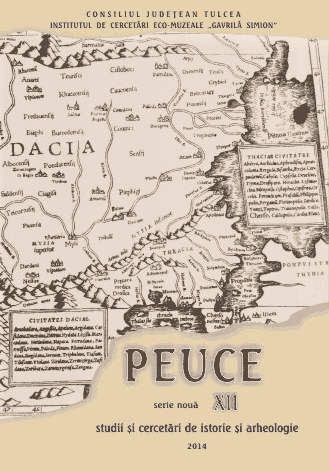Turibula descoperite la Noviodunum–Isaccea
Turibula Discovered at Noviodunum–Isaccea
Author(s): Laurenţiu RaduSubject(s): Archaeology
Published by: Institutul de Cercetari Eco-Muzeale Tulcea - Institutul de Istorie si Arheologie
Keywords: Noviodunum; turibula; censer; Early Roman pottery; Dobroudja; afumătoare; ceramică romană timpurie; Dobrogea.
Summary/Abstract: The article presents a number of 25 fragments of pottery discovered at Noviodunum–Isaccea from turibula, ceramic category related to the presence of Roman troops. It was probably used for religious purposes in a military cult. This ceramic is cone, or deep cup- shaped. Its rim flared and bordered in two parts is decorated with rows of impressions made with a toothed wheel or with a sharp-pointed tool. The defining decoration piece of this ceramic category are the pockets made by squeezing between the fingers of the two rip ends, when modelling, which gives the upper edge a wavy appearance. The ceramic fragments discovered at Noviodunum belong to the medium-sized type, having a diameter between 18 and 26 cm and showing no traces of secondary burning to the inside, which proves that the vessels were not used as smoke pots. We believe that these fragments come from a ceramic workshop, yet undiscovered, situated in the civil settlement of the borough. Specimens have analogues in Troesmis, Niculiţel and Capaclia, dated 2nd century AD, except for a fragment similar to those discovered at Alburnus Maior, dated the second and third centuries AD. Rezumat: Articolul prezintă un număr de 25 fragmente ceramice descoperite la Noviodunum–Isaccea, provenind de la turibula, categorie ceramică legată de prezenţa trupelor romane. Probabil era utilizată pentru scopuri religioase, într-un cult militar. Acest tip ceramic are o formă conică sau de cupă cu pereţii înalţi. Buza, evazată şi delimitată în două părţi, este decorată cu şiruri de impresiuni realizate cu rotiţa dinţată sau cu ajutorul unui instrument cu vârful ascuţit. Elementul de decor definitoriu al acestei categorii ceramice sunt alveolele, realizate prin strângerea între degete a celor două extremităţi ale buzei, la momentul modelării, fapt ce conferă marginii superioare un aspect ondulat. Fragmentele ceramice descoperite la Noviodunum aparţin tipului de dimensiuni medii, cu diametrul cuprins între 18 şi 26 cm şi nu prezintă urme de ardere secundară la interior, ceea ce arată ca vasele nu au fost utilizate ca afumători. Considerăm că aceste fragmente provin de la un atelier ceramic, încă nedescoperit, situat în aşezarea civilă a cetăţii. Exemplarele au analogii la Troesmis, Niculiţel şi Capaclia, datate în sec. al II-lea p.Chr., cu excepţia unui fragment asemănător celor descoperite la Alburnus Maior, datate în sec. II-III p.Chr.
Journal: Peuce (Serie Nouă) - Studii şi cercetari de istorie şi arheologie
- Issue Year: XII/2014
- Issue No: 12
- Page Range: 99-114
- Page Count: 16
- Language: Romanian

